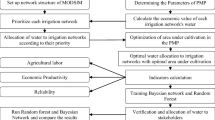Abstract
Bushfires in water supply catchments can adversely impact the reliability of water supply and thus threaten the wellbeing and prosperity of a city. Frequent fire events are looming to threaten water supply from the forested catchments of Victoria, Australia. Melbourne, the capital of Victoria, has to meet growing water demand due to population increase and economic development. In recent years, the state has confronted with severe drought conditions, resulting in a considerable reduction of the water supply yield of the catchments. These continued multi-year droughts culminated into the latest major bushfire in 2009 (Black Saturday). Thomson catchment, the largest water supply catchment supplying water in Melbourne is fully forested. This catchment is comprised of different Ash-type forests, Mixed species, Alpine vegetation, and Scrubs. The study noted that there is probability of occurrence of high danger fire events at 1 in 20-year return period for Thomson catchment. The objective of this study was to carry out a joint probability analysis for different percentages of catchment burning, if a 20-year fire event occurs at least once between 2010 and the given year, and determine the percent reductions in water yield from years 2030 to 2090. Based on the analysis carried out in the study, if 5% of the Ash-type forest is burnt once since 2010, the combined reduction of the total water yield would be 6.75% (16,968 ML/year) by 2090.




Similar content being viewed by others
References
Asadieh B, Krakauer NY (2015) Global trends in extreme precipitation: climate models versus observations. Hydrol Earth Syst Sci 19:877–891
Benyon R, England J, Eastham J, Polglase P, White D (2007) Tree water use in forestry compared to other dry-land agricultural crops in the Victorian context. In: Report prepared for the Department of Primary Industries Victoria to promote scientific knowledge in this area. Ensis Technical Report number 159
Cliamte Council (2017) https://www.climatecouncil.org.au/uploads/1b331044fb03fd0997c4a4946705606b.pdf
Cornish PM, Vertessy RA (2001) Forest age-induced changes in evapotranspiration and water yield in eucalypt forest. J Hydrol 242:43–63
eWater CRC (2008) Hydrological studies into the impact of timber harvesting on water yield in state forests supplying water to Melbourne—Part 2 of hydrological studies (Climate Change and Bushfire). www.water.vic.gov.au/__data/assets/pdf…/HydrologicalStudyPart1a.pdf, last accessed on 15th March, 2012
Khastagir A (2008) Optimal use of rainwater tanks to minimize residential water consumption. Masters by Research, Civil, Environmental and Chemical Engineering, RMIT University, Melbourne
Khastagir A (2013) Risk and severity of bushfires and the impact on water supply reliability in Victoria, Australia. Ph.D. Thesis, RMIT University
Khastagir A (2018) Fire frequency analysis for different climactic stations in Victoria. Nat Hazards 93:787–802
Khastagir A, Jayasuriya N (2008) Role of rainwater tanks in managing demand during droughts. In: Cheesman C (ed) Enviro 08 Proceedings, Australia, 05–07 May 2008
Khastagir A, Jayasuriya N, Bhuyian M (2017) Use of regionalisation approach to develop fire frequency curves for Victoria, Australia. Theoret Appl Climatol 134:849–858
Khastagir A, Jayasuriya N, Bhuyian M (2018) Assessment of fire danger vulnerability using McArthur’s forest and grass fire danger indices. Nat Hazards 94:1277–1291
Kovner J (1956) Evapotranspiration and water yields following forest cutting and natural regrowth. In: Proceedings, Society of American Foresters. Society of American Foresters, pp 106–110
Kuczera G (1985) Prediction of water yield reduction following a bushfire in ash mixed species eucalyptus forest. Melbourne and Metropolitan Board of Works, Melbourne
Kuczera G (1987) Prediction of water yield reductions following a bushfire in ash-mixed species eucalypt forest. J Hydrol 94:215–236
Langford KJ (1976) Change in yield of water following a bushfire in a forest of Eucalyptus regnans. J Hydrol 29:87–114
McArthur A (1966) Weather and grassland fire behaviour. Department of National Development, Forestry and Timber Bureau Leaflet No. 100. Canberra, Australia
McArthur A (1967) Fire behaviour in eucalypt forests. Department of National Development, Forestry and Timber Bureau Leaflet No. 107. Canberra, Australia
Mein R, Jayasuriya LNN, Jayasuriya MDA, O’Shaughnessy PJ (1992) Simulation of water yield to evaluate the impact of timber harvesting strategies for the Thomson catchment. In: Proceedings of hydrology and water resources symposium, Newcastle, June 30–July 2, 1992
Melbourne Water (2018) Water storage and use https://www.melbournewater.com.au/water/water-storage-and-use#/. Last Accessed 14th August 2018
Melbourne Water (2019) Thomson river https://www.melbournewater.com.au/community-and-education/about-our-water/waterstorage-reservoirs/Thomson. Last Accessed 5th June 2019
National Fire Warning System (2009) New warning system explained. http://www.cfaconnect.net.au/index.php?option=com_k2&view=item&id=873. Last Accessed 2nd December 2009
Noble I, Bary G, Gill A (1980) McArthur’s fire-danger meters expressed as equations. Aust J Ecol 5:201–203
Peel M, Watson F, Vertessy R, Lau A, Watson I, Sutton M, Rhodes B (2000) Predicting the water yield impacts of forest disturbance in the Maroondah and Thomson reservoirs using the macaque model. In: Technical report 00/04
Poff NL, Schmidt J (2016) How dams can go with the flow. Science 353:1099–1100
Read Sturgess and Associates (1994) Phase tow of the study into the economic values of wood and water for the Thomson catchment. Read Sturgess and Associates
Roberts S, Vertessy R, Grayson R (2001) Transpiration from Eucalyptus sieberi forests of different age. For Ecol Manag 143:153–161
van Dijk AIJM, Keenan RJ (2007) Planted forests and water in perspective. For Ecol Manage 251:1–9
Vertessy RA, Hatton TJ, O’Shaughnessy PJ, Jayasuriya MDA (1993) Predicting water yield from a mountain ash forest catchment using a terrain analysis based catchment model. J Hydrol 150:665–700
Vertessy R, Watson F, O’Sullivan S, Davis S, Campbell R, Benyon R, Haydon S (1998) Predicting water yield from mountain ash forest catchments. In: Industry report 98/4. Cooperative Research Centre for Catchment Hydrology, Clayton
Vertessy RA, Watson FG, O'Sullivan SK (2001) Factors determining relations between stand age and catchment water balance in mountain ash forests. For Ecol Manag 143:13–26
Author information
Authors and Affiliations
Corresponding author
Additional information
Publisher's Note
Springer Nature remains neutral with regard to jurisdictional claims in published maps and institutional affiliations.
Rights and permissions
About this article
Cite this article
Khastagir, A., Jayasuriya, N. & Bhuiyan, M.A. The use of joint probability analysis to predict water yield for Thomson catchment in Victoria, Australia. Nat Hazards 104, 2619–2634 (2020). https://doi.org/10.1007/s11069-020-04288-y
Received:
Accepted:
Published:
Issue Date:
DOI: https://doi.org/10.1007/s11069-020-04288-y




